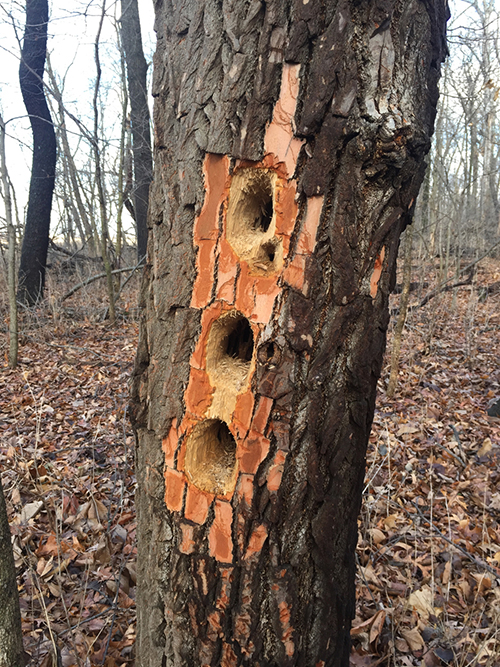
MIKE MILLER
When I first became involved with bird counts back in the 1980s seeing a Pileated Woodpecker in the Peoria area was a rarity. The first time a Pileated Woodpecker was observed on the Peoria Christmas Bird Count was in 1981, by Dr. Bert Princen at Forest Park Nature Preserve. The numbers of Pileated Woodpeckers we would see on the Peoria Count was quite low and sporadic until about 1995. Then the numbers became higher and more regular. It was during the early 1990s that the Pileated Woodpecker started to once again nest in our forests in the Peoria area. Last year on the 119th Peoria CBC, we set the high-count record and observed 18 Pileateds.
Even though Pileated Woodpeckers have become more common in our woods, actually seeing them can be a challenge. You would think that a large black and white bird with a red crest would be easy to spot, but they can be pretty secretive. You will often hear them before you see them. Their loud “cuck, cuck, cuck” call sounds similar to a Northern Flicker (another species of woodpecker), but it is slower and louder. During the spring when they excavate a tree-hole for a nest, the sound of their pounding can carry far into the forest. They often nest in creek-valleys and will build their nests in the dead branches of large cottonwood and sycamore trees. They only use the nest for one season and will raise only one brood of 3-5 young. Once they are done with a nest, it is often used by flying squirrels or screech owls the following year.

PHOTO BY MIKE MILLER
Evidence of a Pileated Woodpecker feeding at a sassafras tree in Singing Woods Nature Preserve.
When you walk through a woods that is home to a family of Pileateds, keep your eyes open for evidence that they have been feeding. They particularly enjoy tearing apart Sassafras trees in search of carpenter ants. In the process they will leave several rectangular shaped holes up and down the trunk. These holes will go deep to the center of the tree where the carpenter ants have built their galleries. Their ability to tear apart wood in amazing to watch. I had the opportunity to observe a Pileated feeding, and they can throw large chips effortlessly. It is like watching a skilled lumberjack using an axe on a tree.
As you wander the woods this winter keep your eyes and ears open for this remarkable bird. Native American legend often cites that the woodpecker is a harbinger of opportunity and change. The recent increase in Pileated numbers in our region certainly gives us hope that nature can bounce back and the future will be bright.

2 comments for “Nature Rambles | The return of the Pileated Woodpecker”
Recent Comments
Our local pileateds are working hard on our sasafrasses! Love to hear their calls early in the morning…so sassy! We have several in our “neck of the woods,”
I was looking up information on the Pileared Woodpecker because it was the first time I observed some in my yard, in Peoria. My fiancé and I actually watched 5 of them fly about and call to each other. I did not realize they were in such small numbers here.